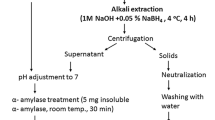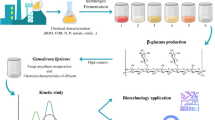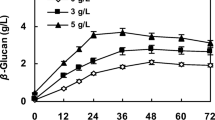Abstract
Botryosphaeria rhodina produced β-glucan when grown on undiluted olive-mill wastewaters (OMW). The production of exopolysaccharide increased with the COD up to 17.2 g l−1 on the most loaded OMW (151 and 66 g l−1 of COD and total sugar, respectively). The total phenol content of OMW was reduced from 8 to 4.1 g l−1.
Similar content being viewed by others
References
Fenice M, Federici F, Giovannozzi Sermanni G, D'Annibale A (2003) Submerged and solid-state production of laccase and Mnperoxidase by Panus tigrinus on olive mill wastewater-based media. J. Biotechnol. 100: 77–85.
Fiorelli F, Pasetti L, Galli E (1996) Fertility-promoting metabolites produced by Azotobacter vinelandii grown on olive-mill wastewaters. Int. Biodeter. Biodegr. 38: 165–167.
Lopez MJ, Ramos-Cormenzana A (1996) Xanthan production from olive-mill wastewaters. Int. Biodeter. Biodegr. 37: 263–270.
Lopez MJ, Moreno J, Ramos-Cormenzana A (2001a) The effect of olive mill wastewaters variability on xanthan production. J. Appl. Microbiol. 90: 829–835.
Lopez MJ, Moreno J, Ramos-Cormenzana A (2001b) Xanthomonas campestris strain selection for xanthan production from olive mill wastewaters. Water Res. 35: 1828–1830.
Petruccioli M, Federici F (1993) Glucose oxidase production by Penicillium variabile: effect of medium composition. J. Appl. Bacteriol. 75: 369–372.
Petruccioli M, Duarte JC, Eusebio A, Federici F (2002) Aerobic treatment of winery wastewater using a jet-loop activated sludge reactor. Proc. Biochem. 37: 821–829.
Petruccioli M, Servili M, Montedoro GF, Federici F (1988) Development of a recycle procedure for the utilisation of vegetation waters in the olive-oil extraction process. Biotechnol. Lett. 10: 55–60.
Ramos-Cormenzana A, Monteoliva-Sanchez Lopez MJ (1995) Bioremediation of alpechin. Int. Biodeter. Biodegr. 35: 249–268.
Sayadi S, Allouche N, Jaoua M, Aloui F (2000) Detrimental effects of high molecular-mass polyphenols on olive mill wastewater biotreatment. Proc. Biochem. 35: 725–735.
Selbmann L, Crognale S, Petruccioli M (2002) Exoplysaccharide production from Sclerotium glucanicum NRRL 3006 and Botryosphaeria rhodina DABAC-P82 on raw and hydrolysed starchy materials. Lett. Appl. Microbiol. 34: 51–55.
Selbmann L, Stingele F, Petruccioli M (2003) Exopolysaccharide production by filamentous fungi: the example of Botryosphaeria rhodina. Anton. van Leeuw. 84: 135–145.
Sutherland IW (1996) Microbial biopolymers from agricultural products: production and potential. Int. Biodeter. Biodegr. 38: 249–261.
Taurhesia S, McNeil B (1994) Physicochemical factors affecting the formation of biological response modifier scleroglucan. J. Chem. Tech. Biotechnol. 59: 157–163.
Author information
Authors and Affiliations
Corresponding author
Rights and permissions
About this article
Cite this article
Crognale, S., Federici, F. & Petruccioli, M. β-Glucan production by Botryosphaeria rhodina on undiluted olive-mill wastewaters. Biotechnology Letters 25, 2013–2015 (2003). https://doi.org/10.1023/B:BILE.0000004394.66478.05
Issue Date:
DOI: https://doi.org/10.1023/B:BILE.0000004394.66478.05




